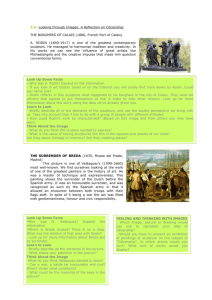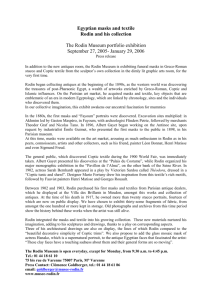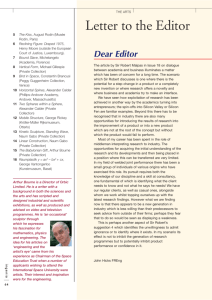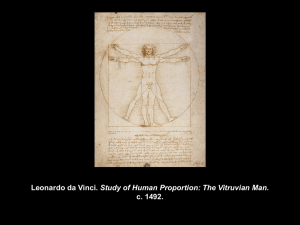gaugin
advertisement
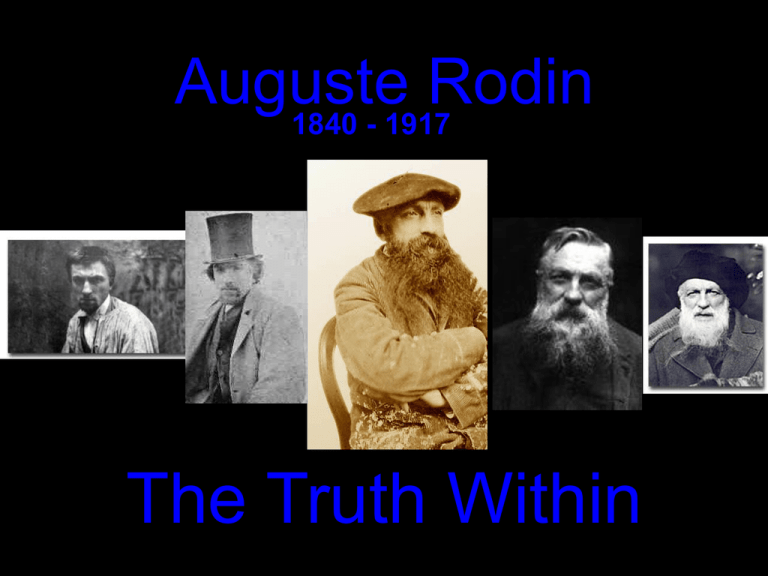
Auguste Rodin 1840 - 1917 The Truth Within Paris, France Paris in 1900 Paris in 1840 Auguste Rodin was born in Paris, France, November 12, 1840. How’d he start? Rodin loved to draw when he was a child. Cambodian Dancers Cambodian Dancer Cambodian Dancer In July 1906, Auguste Rodin went to the palace of the president of France for a garden party featuring the dancers of the Royal Ballet of Cambodia. Rodin showed up with a ticket but no tie. He was turned away, furious. He managed to see the dancers perform in the Bois de Bologne a few days later. What he saw was so pure and startling that it sparked in him a kind of fever he could only describe as love. "I contemplated them in ecstasy," he said. He followed the dancers back to Marseille so precipitately that he left his art supplies behind and had to buy butcher paper from a grocer to draw on. Rodin sitting on a bench as he sketches a Cambodian dancer. In 2006, the French government sponsored an exhibition of Rodin’s drawings to celebrate the 100th anniversary of King Sisowath's visit. Schooling He applied to the Ecole des Beaux-Arts three times, but was rejected. Studied at the Petite Ecole, a school of decorative arts in Paris. Began doing decorative sculpture to make a living. Ecole des Beaux-Arts Petite Ecole His sister, Marie, died four years later. This so traumatized Rodin that he entered a monastery. Rodin in 1863 working on a bust of Father Eymard. Rose In 1864, met Rose Beuret, a seamstress, who (much later) became his wife. Sculptor’s Assistant For many years, Rodin worked as an assistant to one of France’s most famous decorative sculptors. After seeing the work of Michelangelo in Italy, 1875, he was inspired to create less commercial, more artistic works. Dying Slave, by Michelangelo The Age of Bronze Caused a scandal because the critics could not believe Rodin didn’t use a casting of a live model to create the sculpture. Look familiar? It’s called The Age of Bronze, by Rodin, 1876 Controversy = Career Boost Five years later, Rodin was comissioned to create a magnificent door called The Gates of Hell (from Dante’s Inferno) for the yet unbuilt Museum of Decorative Arts. Still Waiting… Ug! A train station?! The casting wasn’t completed until after Rodin’s death, almost 40 years later, and the Museum was never built. Instead, they built a train station (!) The arts get no respect! From Depot to Divine 75 years later, the train station was renovated and turned into the current Musee D‘Orsay – a museum containing French art from the 1850s to 1900. The Influence of the Gates Even though The Gates of Hell was unfinished at the time of Rodin’s death, it occupied his mind for many years, providing the basis for some of Rodin’s most influential and powerful work, including our focus for today: The Thinker. Notice the image at the top of the doors – looks familiar! Probably also influenced by The Gates… Famine to Feast After The Gates of Hell, Rodin was commissioned to create many more monuments and statues, many of which are worldfamous. The Burghers of Calais, 1888/1889 Beauty = Inner Truth For Rodin, beauty in art consisted in truthfully representing one’s inner state. For this reason, he sometimes distorted the anatomy for the sake of expressing the emotions more clearly. (Notice the length of the hand?) Man With a Broken Nose, 1864 The Man with the Broken Nose became The Mask of the Man with the Broken Nose when the cold conditions of Rodin's studio caused the back of the head to freeze and break off. Jean-Baptiste Rodin, 1864 Young Girl with Roses, 1872 Suzon, 1875 Victor Hugo, 1883 Portrait Head of Victor Hugo Detail from The Burghers of Calais, 1888/1889 Giant Head of Pierre de Wiessant, 1889 The Genius of War Auguste Rodin, 1888/1889 Hand of the Devil Hand of God, 1898 Thought, 1898 The Secret, 1910 Hand Coming Out of a Tomb Rodin’s funeral in Meudon, November 24, 1917. Our Masterpiece The Thinker, 1880 So what am I going to ask you to do? Naturalism vs. Realism. You will be sculpting the head of a person. •You will receive a zip-lock bag containing a plastic knife, a wooden carving tool, and a bar of soap. •The bag will have your name on it. •Keep the bag! You will place your finished carving inside. •Unwrap the soap (duh). •This project should be done outside so throw away the soap wrapper on your way out of the classroom. Imagine the face/head you will carve. Using one of the tools, lightly sketch into the soap where the shape of the face, eyes, nose, mouth, hair, etc. will be placed. Begin by shaving off little bits of soap. If you do too much, the soap could crack & break. Look at the face of a classmate. Consider the highest point (the nose) and the most recessed (neck). You should hardly touch the highest point, but you will have to shave off much to get down to the neck area. foreground midground background Remember to carve all sides of the soap. This is a 3-dimensional piece of art. In a 3-D work of art we will be working with form. The form of the soap when we begin was a slab. Carefully cradle the soap in your hands and whittle away areas to change the slab form with straight edges to a form with rounded edges and indentations. When you have finished, place your soap carving in the zip-lock bag. Return the plastic knife, carving tool and soap sculpture to me. I have a word search for those who finish early.
